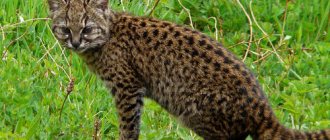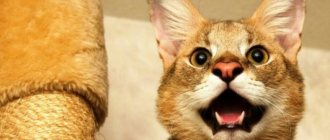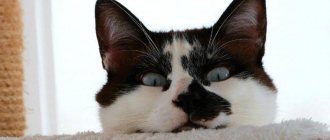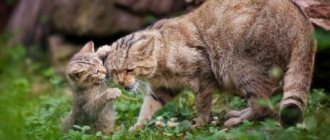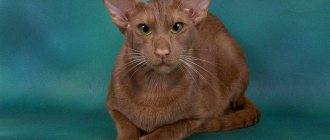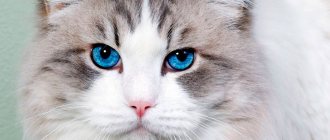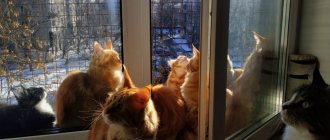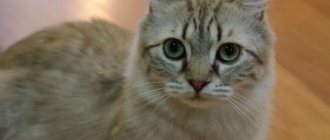Black cats with blue eyes look noble. Even no less noble than the snow-white beauties. Therefore, they are worth learning more about these coal-black beauties, including the difficult fate that befell them because of their black color.
Blue eye color has always attracted the attention of breeders. Well, as for black cats with blue eyes, they seem to be some kind of magical, mystical creatures, which aroused more and more interest among some people, and superstitious fear among others. However, if you yourself are not the source of harm to the cat, there is no reason to be afraid of it.
Heterochromia looks even more mysterious than just a combination of blue eyes and black color.
Black color in various combinations is present in almost all breeds. But before, and even now at times, absolutely black cats are unlucky, and they are accused of everything, trying to avoid them.
Still from the cartoon “The Scarecrow-Meow”.
Although for the Egyptians these animals were considered sacred, in the Middle Ages they were less fortunate - black cats were burned at the stake along with “sorcerers” and “witches”.
Many scientists are of the opinion that it was black cats that were the ancestors of today's pets. In addition, their black coloration gives them an advantage when hunting at night, which likely contributed to their high prevalence and survival rate.
Genetics of black color
Many Internet pages are full of photographs of black cats. What gives these animals such a beautiful color? The pigment eumelanin, which is responsible for the formation of black color, is responsible for this. This pigment is present in the cat’s hair in the form of granules, and the shade of the cat’s color depends on what shape they are, how much they are contained and where they are located. For example, the rich black color of the coat is given by the B (Black) gene in a dominant state. In this case, the eumelanin granules have a slightly elongated shape at the poles and are placed very tightly. In other, recessive conditions, the gene contributes to the appearance of calmer shades. Thus, species b pulls out pigment granules and separates them over long distances, resulting in a chocolate color. And the bl form further expands and moves the granules away from each other, resulting in a cinnamon color.
In most cases, black cats give birth to black kittens.
Perfect black cats are rare. At least minimally lightened areas are still present on the body, but they are often very well hidden and not noticeable.
Black cats are not a separate class. This color can be found in any breed. But blue eyes among them are a very rare phenomenon. Here are some of the cases where black cats have been observed to have blue eyes:
Bombay
Kittens are usually born with blue eyes, but as they age the color changes to yellow.
Oriental
Black Orientals even have jet black noses and toes.
Canadian Sphynx
Canadian Sphynx cats have unusually short mustaches.
Collection of problems on cat genetics
State Institution "Forest Secondary School of Zhelezinsky District"
Collection of problems
on cat genetics
2015
Author - compiler: 8th grade student, Lesnaya secondary school of Zhelezinsky district.
Scientific supervisor: teacher of biology and chemistry, Lesnaya secondary school of Zhelezinsky district.
Content
| Introduction | 3 | |
| Basic rules to help solve genetic problems | 4 | |
| Elementary rules of cat genetics | 5 | |
| 1 | Monohybrid cross | 7 |
| 2 | Independent inheritance | 10 |
| 2.1 | Dihybrid cross | 10 |
| 2.2 | Polyhybrid crossing | 12 |
| 3 | Interaction of nonallelic genes | 13 |
| 3.1 | Complementarity | 13 |
| 3.2 | Epistasis | 14 |
| 4 | Chained inheritance | 15 |
| 5 | Inheritance of lethal genes | 17 |
| List of sources used | 18 |
INTRODUCTION
Genetics is the science of heredity and variability of organisms. It is designed to reveal the laws of reproduction of living things through generations, the emergence of new properties in organisms, the laws of individual development of an individual, serves the practice of agriculture and medicine, protection
human heredity from damage.
Clarifying the essence of reproduction for a specific variety of life forms requires studying the phenomena of heredity in representatives at different stages of evolutionary development. The objects of genetics are viruses, bacteria, plants, animals and humans. In the phenomena of heredity, general laws are found for all living beings. Their existence shows the unity of the organic world.
Get the full text See all projects
Publish articles
Its basis is the cell - an elementary system necessary for the manifestation of life at all levels of its organization. Genetics is closely related to breeding and medicine. Selection is the science of targeted transformation of animal breeds, plant varieties, races of microorganisms, bacteria and viruses. To solve these problems, knowledge of the general laws of heredity is very important.
The most important challenges are facing human genetics. The deep interest of medicine in problems of genetics is caused by the study of a broad category of hereditary diseases. Having achieved the possibility of studying heredity at the molecular and genetic level, modern genetics is quickly solving many medical problems, although many unresolved questions remain.
The general biology course examines extensive theoretical material on the laws of heredity and variability. The mechanisms of variability and heredity are examined in detail, and genetic laws are colorfully illustrated.
Genetics deals with solving theoretical problems and reveals the mechanisms of inheritance of traits, but this is only one of its sides. An important role is played by practical research, the purpose of which is to test the theory, and in breeding, to develop new breeds of animals, plant varieties, etc.
A real idea of the significance of science can be obtained by becoming familiar with the various problems solved by geneticists. This manual is intended for teachers and school students. By solving genetic tasks, students will practice the basic principles of inheritance of traits, become familiar with the issues that medical genetics and selection solve, which will undoubtedly affect the depth of mastery of this section.
Basic rules that help in solving genetic problems:
Rule 1.
If, when crossing two phenotypically identical individuals, a splitting of characters in a ratio of 3: 1 is observed in their offspring, then these individuals are heterozygous. (Monohybrid cross with complete dominance.)
Rule 2.
If, when crossing phenotypically identical (one pair of traits) individuals in the first generation of hybrids, the trait splits into three phenotypic groups in the ratio 1: 2: 1, then this indicates incomplete dominance and that the parent individuals are heterozygous. (Monohybrid crossing with incomplete dominance.)
Rule 3.
If, as a result of crossing individuals that differ from each other phenotypically in one pair of traits, offspring are obtained that are split in the same pair of traits in a 1:1 ratio, then one of the parent individuals was heterozygous, and the other was homozygous for a recessive trait.
Rule 4.
If, when crossing two phenotypically identical individuals, the characteristics in the offspring are split in the ratio 9: 3: 3: 1, then the original (data) individuals were diheterozygous. (Dihybrid cross.)
ELEMENTARY RULES OF CAT GENETICS.
Read on, and there will be far fewer questions about cat colors!
1. Two long-haired parents cannot produce a short-haired kitten.
2.Only the parents' colors determine the color of the kitten. The colors of other cats present in the pedigree do not have a direct effect on the color of the kitten.
3. A cat kitten always gets its color from its mother.
4. A cat kitten always receives a color that is a combination of the colors of the father and mother.
5. To obtain a genetically red or genetically cream-colored cat kitten in the litter, it is necessary that the father be genetically red or genetically cream-colored, and the mother must also have a red or cream-colored genotype.
6. Dominant characteristics (dominant colors: white, veiled, shaded, smoke, tabby and bicolor, etc.) cannot skip a generation. They cannot pass, for example, from grandfather to grandson, without manifesting themselves in the father.
7. A kitten of a dominant color (black, red, tortoiseshell, etc.) must have a parent of a dominant color.
8. Two parents of a recessive color (cream, blue, etc.) cannot produce a kitten of a dominant color (black, red, tortoiseshell, etc.).
9. A white kitten must have a white parent.
10. A kitten with a white undercoat (veiled, shaded, smoky) must have a parent with a white undercoat.
11. A veiled/shaded kitten must have at least one parent who is either a veiled/shaded or a tabby.
12. A veiled/shaded parent can produce a smoky kitten, but a smoky parent cannot produce a veiled/shaded kitten.
13. A tabby kitten must have at least one parent who is veiled or tabby.
14. All red cats have some degree of tabby. The ability to produce tabby offspring depends on whether the red cat (or tom) is a true tabby, that is, whether it has a tabby or veiled/shaded parent, or whether it is simply a red cat with an outward tabby pattern. A red tabby, unless it is a true tabby, cannot produce a tabby offspring of any other color unless it is bred to a true tabby (or a veiled/shaded one).
15. A brindle tabby kitten must have a brindle tabby parent.
16. A spotted tabby kitten must have a spotted tabby parent.
17. Multi-colored individuals (tortie, blue-cream, tortoiseshell with white, blue-cream with white, tortoiseshell smoky, etc.) are almost all cats, but they can be born, and sometimes cats are born.
18. A bicolor kitten must have a bicolor parent.
19. Two color-point parents cannot produce a non-color-point kitten. (see clause 8)
20. It is possible to get a color point kitten only if both parents are carriers of the color point gene (even if they themselves are not color points).
21. If one parent is a color point and the other is not a carrier of the color point gene, there cannot be a single color point kitten in the offspring.
Monohybrid crossing Black coat color (B_) in cats is dominant over chocolate coat color (bb). Indicate the type of gametes formed by crossing: a black homozygous cat with a chocolate cat; black heterozygous cat with a chocolate cat. Determine the phenotypes and genotypes of the offspring. The dominant S gene is responsible for the presence of white spots on a cat’s fur, and the recessive s gene is responsible for the absence.
When crossing two cats with white spots, we got 3 kittens with white spots and 2 kittens without spots.
How many homozygous individuals are there among the offspring? Determine the possible genotypes of the parents. Provided that black color is dominant over gray in cats, what offspring can be expected in the following crosses: Heterozygous gray male and homozygous black female; Gray parents; Black parents, one is homozygous and the other is heterozygous. The W and w genes are responsible for the white color: W_ - completely white coat color, ww - not white. Can white parents produce non-white offspring? Can non-white parents produce white offspring? The Sphinx genes determine whether a cat is bald or not. The natural allele “Hr” is dominant and produces normal coat. The "hr" mutation is recessive and results in hairless Sphynx cats.
What kind of offspring should be expected from crossing:
Two heterozygotes; A homozygous cat with regular hair and a hairless cat; A heterozygous cat with regular hair and a hairless cat. The gene for short hair in a cat is dominant over long hair. A short-haired female was crossed several times with a long-haired male. We received 9 short-haired and 7 long-haired kittens. Determine the genotypes of parents and offspring. Two black cats crossed with a chocolate cat. One cat gave birth to 3 black and 2 brown offspring, and the other gave birth to 6 black offspring. What are the genotypes of parents and offspring?
In cats, short hair is dominant over long hair. What will be the offspring of the first and second generations from crossing a homozygous cat with short hair with a long-haired cat? What are the results of crossing one of the first generation offspring with a long-haired individual? Cats have a series of multiple alleles for the C gene, which determine coat color: C - wild type, C' - Siamese cats, C" - albinos. Each allele is completely dominant over the next (C > C' > C"). From crossing a gray cat with a Siamese cat, two kittens were born - a Siamese and an albino. What other kittens could be born from this crossing? The gray cat was crossed with black cats. All kittens of the first generation were gray. In the second generation, 29 gray and 9 black offspring were obtained. How is gray color inherited? Record the genotypes of the parents. When crossing a smooth-haired cat with long-haired cats, smooth-haired offspring are obtained. Crossing them with each other produced 47 smooth-haired and 15 long-haired offspring. Which trait is dominant? How many homozygous animals are there among the 47 smooth-haired and 15 long-haired kittens of the second generation? How to determine who exactly is homozygous? Tiger parents give birth to a tiger kitten. How to determine whether he is a heterozygote for the marbled color allele? The export of Devonian Rexes from the United Kingdom is prohibited. How, without violating this law, can the re allele be made available to the Novosibirsk Club of Felinologists? A black cat from crossing with an unknown cat brought 3 gray and 3 black offspring. Determine the genotype and phenotype of their father. A brindle cat was crossed with two marbled cats. The first gave birth to 6 brindle kittens, and the second gave birth to 5 brindle and 1 marble. What are the genotypes of all three parents? To improve the local breed of white Angora cats, the white Angora cat Fauntleroy XXIII was brought to Novosibirsk from Edinburgh. He gave birth to 37 kittens, 5 of them were gray and 4 black. Is it only Fauntleroy XXIII who is to blame for this, or is it his wife too? How to install it? What is the probability that any of the 28 white offspring sired by Fauntleroy XXIII are carriers of the gene for unwanted coloration? What will be the offspring from crossing two tailless cats? From a tailless cat and a tailed cat? Which litters will be more numerous? A white piebald cat was crossed with two piebald cats. One gave birth to only piebald offspring, while the other produced 5 piebald offspring and one with solid color. Determine the genotypes of the parents.
Independent inheritance Dihybrid crossing In cats of the Siamese breed, the short hair (A) is dominant over the long hair of the Persian cat (a), and the black coat color (B) of the Persians is dominant in relation to the fawn color (c) of the Siamese breed. Siamese cats were crossed with Persian cats. After crossing the resulting hybrids with each other, 48 kittens were obtained in the second generation. Siamese cats did not have long-haired animals in their family tree, and Persian cats did not have fawn coloring in their family tree. How many types of gametes do Siamese cats have? How many different genotypes are there in the second generation? How many different phenotypes are there in the second generation? How many second generation kittens look like Siamese cats? How many of them are similar to Persian? In cats, a striped tail (A) dominates over a solid one, and long whiskers (B) dominate over short ones.
We crossed two diheterozygotes for these two traits and got 16 kittens.
How many kittens will there be with a striped tail and long whiskers? How many different genotypes will the kittens have? In cats, black coat color (B) dominates over chocolate, and color saturation (D) dominates over lightened coat. Determine the phenotypes of the offspring. How many different genotypes will the kittens have?
If you crossed a gray cat (BBdd) with a purple cat (bbdd).
If white coat color (W) dominates over no coat color, and short coat color (L) dominates over long coat color, what kind of offspring can be expected in the next generations? The cat is diheterozygous with white and short hair, and the cat is a recessive digomozygous. The cat is red and heterozygous for the long-hair gene, the cat is a red cat with short hair. The cat is homozygous for both characteristics, while he has long red hair, and the female cat is diheterozygous. A cat is a recessive digomozygote, and a cat is a diheterozygote. When two black cats were crossed, the offspring produced gray and purple kittens. Determine the possible genotype of the parents if it is known that black coat color (B) dominates over chocolate, and color saturation (D) dominates over lightened coat.
What kind of offspring should be expected from crossing:
a gray cat (BBdd) with a lilac cat (bbdd); black diheterozygous cat with a gray cat; chocolate cat (bbDD) with a lilac cat. In cats, short hair (A) is a dominant trait, and black coat color (B) is dominant over chocolate. A heterozygous black longhair cat was crossed with a heterozygous chocolate shorthair cat and 12 kittens were obtained. How many types of gametes does a cat produce? How many types of gametes does a cat produce? How many shorthaired black kittens will there be? How many long-haired black kittens are there? A black (B) cat with straight (R) hair, heterozygous for the first type of gametes, was crossed with a cat with chocolate curly hair, heterozygous for the first allele. What are the likely genotypes of the children? A gray long-haired cat was crossed with a black smooth-haired cat. Among the offspring were 3 gray smooth-haired, 2 gray long-haired, 2 black smooth-haired and 3 black long-haired. Determine the genotypes of the parents. Which genotype of the offspring, when crossed with its own kind, will not produce splitting? When crossing a blue cat with a brown cat, black offspring are obtained. Determine the genotypes of the parents and predict what the color split will be in the second generation from crossing these black offspring with each other. The breeder dreams of getting a long-haired Siamese breed. He has at his disposal a Siamese shorthair cat and a white longhaired cat, Fauntleroy XXIII. What crosses should he make to get what he wants? From the marriage of a marbled cat with a black cat, brindle and marbled kittens were obtained. What will be the split in the offspring when crossing the descendants of the first generation: tiger with tiger? marble with marble? brindle with marble?
Polyhybrid crossing
2.2.1. The W and w genes are responsible for the white color: WW, Ww - white cat, ww - not white. The W gene overlaps all other genes responsible for color. The gene pool of club cats is represented by genes: B, b, O, o, w. There are no white cats or cats in the club, the dominant W gene is absent in the population.
Get full text
Is it possible to breed a kitten of the desired color with a certain genetic code:
a) BBOOww – red color
b) BBooww – black color
c) BBOOWW – white color
Determine the possible genotypes of the parents to obtain individuals with a given genetic code.
2.2.2. The chocolate cat left the cat club and took his offspring (that is, gene b is no longer in the gene pool). But a white cat appeared in the club. The gene pool now looks like this: B, O, o, W, w. How did the presence of a white cat affect the colors of cats in this population?
2.2.3. The Cornish Rex gene is represented by two alleles: “R” is dominant and produces straight hair. The "r" mutation is recessive and results in a very short, curly coat.
What kind of offspring should you expect if you cross:
A black (B) cat with straight (R) short (L) hair, heterozygous for all types of gametes with a cat with chocolate curly hair. A black (B) cat with straight (R) long (l) hair, heterozygous for the first type of gametes with a cat with black curly hair, heterozygous for the first allele.
2.2.4. The marriage of the white cat Fauntleroy XXIII with the black cat Adelaide XI was long and happy. 60 kittens were obtained from them. Of these, 28 are white, 7 brindle, 9 marbled and 16 black. What are the genotypes of the parents?
2.2.5. The marriage of the white blue-eyed cat Fauntleroy XXIII with the white blue-eyed cat Antoinette XV was no less long and even happier. 60 kittens were obtained from them. Of these, 32 are white, 14 brindle and 16 black. Their black son Wilberforce VII married his own black sister Isabella XVII, and among their 11 offspring were 2 white blue-eyed kittens. Determine Antoinette's genotype.
Interaction of non-allelic genes Complementarity
3.1.1. There are two known recessive genes in cats - b and d, homozygosity for each of which, or both at the same time, causes lilac coloration of the coat. Black coloring is obtained when both dominant alleles B and D are present. In what type of crossing of two lilac cats will all their offspring be black?
3.1.2 Coat color in cats is determined by two pairs of genes located on different chromosomes. In the presence of a dominant gene B, the dominant gene D of the other pair causes black coat color, the recessive gene d – gray (blue) color. In the absence of gene B, the color will be lightened. What color kittens will result from crossing gray diheterozygous cats?
Epistasis
3.2.1. When crossing a black cat with a gray cat, all F1 offspring were black. When these offspring were crossed with each other several times in their F2 offspring, the following was obtained:
8 cats with black coloring, 5 cats with gray coloring, 2 cats with lilac coloring.
Determine possible genotypes of parents and offspring.
3.2.2. In cats, the pattern on the coat is determined by the presence of the dominant T gene. If it is in a recessive state, then the pattern does not develop. The action of this gene is influenced by gene A, which in a recessive state suppresses the development of a trait controlled by the T gene. What offspring will be obtained from crossing cats diheterozygous for these genes?
3.2.3. In cats, the pattern on the coat is determined by the presence of the dominant T gene. If it is in a recessive state, then the pattern does not develop. The action of this gene is influenced by gene A, which in a recessive state suppresses the development of a trait controlled by the T gene. Determine the probability of giving birth to a kitten with a coat pattern from crossing cats with the TTAa and ttAa genotypes.
Linked inheritance The O and O genes, which are involved in determining the color of cats, are localized on the X chromosome. The O gene causes red coloration, the O gene causes black coloration, and Oo heterozygotes have a variegated (“tortoiseshell”) coloration. A motley cat has 4 kittens from a black cat (2 of them are female), what color are they? The O and O genes, which are involved in determining the color of cats, are localized on the X chromosome. Black coloring is determined by the XO gene, red coloring is determined by Xo, XOXo heterozygotes have a tortoiseshell coloration. From a black cat and a red cat were born: one tortoiseshell and one black kitten. Make a diagram for solving the problem. Determine the genotypes of parents and offspring. Determine the possible gender of the kittens. What kind of offspring can be expected as a result of mating a red cat with a black cat? What kind of offspring can be expected as a result of mating a red cat with a tortoiseshell cat? What kind of offspring can be expected as a result of mating a black cat with a tortoiseshell cat? What kind of offspring should be expected as a result of crossing a tortoiseshell cat with white spots on the coat with a solid black cat, if it is known that the dominant S gene is responsible for the presence of white spots on the cat’s coat, and the recessive s gene is responsible for the absence. At what combinations of parental genes can a golden tortoiseshell chinchilla appear in the offspring, if it is known that the golden chinchilla has the ooTTa genotype. What gender will this individual be? The calico color, formed by a combination of the orange gene - Oo, with the solid color gene and the white spot gene - S_, like tortoiseshell, is found only in cats. At what combinations of parental genes can an individual with a given color appear in the offspring. It is known that three-haired cats are always female. This is due to the fact that the genes for black and red colors are allelic and are located on the X chromosome, but none of the genes dominates, and when the genes for black and red coat colors are found together in the genotype, a “tortoiseshell” color is formed. What kind of offspring will be observed when crossing a black cat with a ginger cat? In cats, yellow coloring is determined by the dominant B gene, black coloring is determined by b. The Bb heterozygote has a tortoiseshell coat color. Gene B is linked to gender. What kittens can do if the cat is black and the cat is yellow? Can a cat be tortoiseshell? A black cat brought kittens, one of which has a tortoiseshell coat color, and three have black fur. What can be said about the genotype of kittens? What is their gender? A ginger tabby whose mother was a ginger tabby and whose father was a merle is crossed with a merle. What kind of offspring should be expected from such a marriage? A tortoiseshell long-haired cat gave birth to five kittens from an unknown cat: a gray short-haired kitten, a tortoiseshell long-haired cat, a red short-haired kitten with six toes on the front paw, and a gray long-haired cat. Determine the genotype of the unidentified cat.
What kind of kittens will be obtained from crossing: a black cat with a ginger cat; red cat with a black cat?
Inheritance of lethal genes
5.1. The Manx cat gene, which is responsible for the length of the tail, is represented by two alleles: the natural allele “m” is recessive and forms a tail of normal length. The "M" mutation is dominant and results in the absence of a tail. This mutation is lethal for homozygotes.
What is the probability of producing a homozygous individual when crossing two heterozygotes?
5.2. The Mansky cat gene is lethal for dominant homozygotes. What genotypes should parents have to avoid the birth of such an individual?
5.3. The lop ear gene is represented by two alleles: the natural allele “fd” is recessive and produces normal ears. The "Fd" mutation is dominant and results in pinned ears. This mutation is lethal for homozygotes.
What is the probability of producing a homozygous individual when crossing two heterozygotes?
5.4. The lop ear gene is lethal for dominant homozygotes. What genotypes should parents have to avoid the birth of such an individual?
5.5. When crossing two tailless cats, 6 tailless cats and 3 tailed cats were obtained. Determine the genotypes of the parents. Explain the reasons for the deviation from Mendelian segregation.
List of sources used:
, ,, Yarygin / Pod. Ed. . M., Medicine, 1985, Tikhomirova for practical classes in genetics. M., Education, 1983 Skokova problems in genetics. Ryazan, "Horizon", 1993 Helevin on general and medical genetics. M., Higher School, 1984. , Krivoshetna on medical genetics. M., Academy, 2003.
Are blue eyes in cats rare or an exception?
Blue eyes are very rare in black cats.
In fact, blue eye color is quite common, especially in light-colored cats. Kittens are born with blue eyes, but this color may change with age. It all depends on the pigmentation, but there are completely inexplicable exceptions. In general, cats with black fur and blue eyes are very rare.
Origin story
The exact origin of Russian Blue cats could not be established, since the breed had many names before the final one was chosen. One of the versions suggests that this breed of cats was brought by a sailor from Arkhangelsk to England in the 60s of the 19th century, then the breed was called Arkhangelsk.
Later the names changed to "Spanish Blue Cat" and "Maltese Blue Cat". But despite its rather mysterious origin and incredible color, the Russian Blue cat breed still could not become as popular as long-haired blue or British blue cats in the late 19th and early 20th centuries.
These cats stood out so much from the others that many thought they were separate breeds. But in reality, the name "British Blue" only means a British Shorthair cat with blue coloring, and "Persian Blue" is just one of the many colors of Persian cats.
In 1939, the name was officially assigned to this breed - Russian Blue cat. After World War II, the popularity of the breed began to decline and, after some time, breeders were forced to cross Russian Blue cats with British Shorthair and Blue Point Siamese cats.
But as a result of this, the characteristics of the breed were gradually lost, so it was decided to return blue cats to their original appearance - with a shorter body and darker colors. Russian blue cats have become most popular in the USA and Japan.
It is worth remembering that back in the 80s of the last century, American breeders bred Russian blue cats with semi-long hair. This breed received a separate name - “Nibelung”, and already in 1987 the International Association of Cat Fanciers recognized it as a separate breed.
However, even now Nibelung cats are quite rare. And finally, let’s note the shortcomings of the breed, or rather the traits that are considered to be them. And this: a down-to-earth body posture, a roundish or square-shaped head, as well as yellow spots in the green color of the eyes.
Description of the breed
| Breed name: | Russian blue cat |
| Country of origin: | Russia |
| Time of origin of the breed: | unknown |
| Weight: | 2 – 7 kg |
| EMS code: | RUS |
| Lifespan: | 10 – 20 years |
| Price of kittens: | 20 – 300 $ |
| The most popular nicknames: | list of nicknames for Russian blue cats |
Pets of the Russian Blue cat breed are endowed with a sophisticated, beautiful body, a wedge-shaped head with a narrow skull, which makes them stand out among similar breeds. But the main feature that distinguishes this cat breed from others is its shiny short blue hair.
At the same time, the coat itself and the undercoat are of the same length, due to which the inherent “plush effect” is similar to that of the British Shorthair chinchilla cat.
Breed standard - appearance
The Russian Blue kitten differs from others not only in its ash-blue color, which is the first thing that catches your eye when you look at pictures of it, but also in a number of other differences (standard).
- The head is shaped like a blade (from the eyes to the tip of the nose if you draw lines between three points). The head is flat on top and the skull is long.
- The cat's neck is straight and quite long.
- The body of the “Russian Blue” is quite graceful. Its neat, medium-sized body with a rather elongated body distinguishes the cat from other standards.
- The ears are wide at the base, pointed at the tips, large. They are pink inside with a small amount of hair.
- The eyes, like almonds, are set wide apart, have a beautiful green color and are very expressive.
- The limbs are long, like everything else. The paws can be either oval or round in shape. The tail is thin and sharp at the tip.
- The coat is short. It cannot be called fluffy, but it is very thick and soft, very similar to plush (to the touch). Consists of both undercoat and hair on top.
Blue-eyed black cats - Ojos Azules
Ojos Azules are one of the most mysterious breeds.
Ojos Azules is the only breed that combines black coat color and blue eyes, not as a huge exception. At first these cats had a tortoiseshell color, but after numerous crossings individuals with black fur were obtained.
Temperament and behavior
Their color can be varied, but the color of their eyes is always blue.
These cats are very calm and attached to their owner. They love attention, but will not attract it too intrusively and distract others from their work. Okhs cannot spend time without the company of their owner for a long time, but they are not entirely sociable with other pets. They love to play and when interacting with children they are not dangerous to them (of course, until they consider the children themselves dangerous to themselves - in this case, they will undoubtedly defend themselves without regard to the age of the person in front of them).
Features of care
Thanks to its silky texture, the cat's fur rarely gets tangled.
It is enough to brush cats of this breed several times a month, because although they can have both long and short hair, at the same time they have a sparse undercoat. In addition, it is important to trim the claws on time, firstly, so that the cat does not hurt itself, and secondly, so that it does not start sharpening them on everything it sees if there is no scratching post.
Health
Okhs have good health.
The most important feature of the breed, which should not be forgotten, is that representatives of this breed cannot be crossed with each other, as well as with other breeds if they have blue eyes - there is a high risk of sick, inferior or even dead offspring. In other cases, there is no need to worry, since representatives of the Ojos Azules breed have good immunity and good health. At the moment, no diseases characteristic of her have been identified. With proper nutrition and care, they can live up to seventeen years, and in some cases longer.
Two-color cats - signs
Every shade has its own symbolism. Including when it comes to the color of the animal.
- A smoky gray cat's coat helps owners deal with stress and smoothes out conflicts.
The usual gray color gives wisdom, red promises prosperity and the favor of fortune to ambitious owners.
The signs about white and black cats are especially categorical:
- Snow-white pet - concentrated healing power;
- Black - development of hidden talents, intuition, magical abilities, protection from evil.
The contrasting combination of shades in bicolor is not just beauty, but also a huge benefit for the owner. Signs about two-color cats relate to different color options:
- The combination of red and white, for example, is characteristic of the strongest “accumulators”.
Pets receive energy directly from the Sun, accumulate it within themselves, and, if necessary, generously share it with the owner - cure diseases or help achieve success in their chosen field.
Rules for caring for black fur
Black fur can fade in the sun, so if you want to maintain the jet black color of your cat's fur, you need to control the amount of time he is exposed to direct sunlight.
Black wool partly requires a special approach. So, you should not let your cat walk for a long time under the scorching sun, as the fur may fade and red spots will appear on the fur coat.
A cat's fur is an indicator of its health. If the fur coat begins to fade and fall out a lot, you should reconsider your pet’s diet and show it to the veterinarian.
Otherwise, the rules of nutrition and care are generally similar for all types of cats, but you need to follow the care features of each breed. For example, Manx cats have a thick undercoat, and therefore need to be combed thoroughly, but bathed no more than twice a year, using special shampoos and conditioners to enhance shine. Maine Coons need to be brushed at least once a week, while Persians and Siberians with long hair require special care. They need to be combed daily in three stages: first with a wide-toothed comb, then with a slicker brush, and finally with a fine-toothed comb. You can bathe them four times a year, after which you treat the wool with a special product to make combing easier.
What to feed a Siberian cat
Representatives of the Siberian Blue breed eat with appetite everything that is offered. But it is advisable to feed them not with store-bought food, but with natural food.
The diet includes:
- raw and cooked meat;
- boiled fish and seafood;
- offal;
- eggs;
- goat milk, low-fat cream, fermented milk products;
- cereal porridge.
“Siberians” do not have a tendency to have an allergic reaction, but some individuals may be intolerant to lactose and chicken meat.
Liver should not be given to a cat with light fur often. Otherwise, the guard hairs will darken.
Brown (golden) Bengal cat
The brown (or golden) Bengal (C,C color genes) is the most popular of the Bengal cats, and was the first cat to be recognized by TICA in 1983.
Traditional brown Bengals have green or gold eyes.
The background color can vary from a gray-brown tone to a bright orange-gold.
The color of the spots, rosettes, or marbles can range from black/light brown to darker or reddish brown.
If you have a brown furry friend, you probably know that brown comes in a variety of shades such as: gold, cream, dance, honey, taupe, dance, beige, caramel, cinnamon.
All shades of brown are acceptable, but orange-brown is preferred for the main background color of the coat.
As you can see, almost all shades of brown are available for the Bengal breed.
Now, if you look at a brown (golden) Bengal, you will notice the following characteristics:
– Brown tail with a black tip – Pink nose – Brown, copper, gold, green or brown eyes – White belly preferred
Magnificent creatures, aren't they?
Bonus: Marble Spot or Sparbl
)
Do you think that spotted and marbling patterns have never been seen before?
Look at the coloring where the spots and marbling merge. "Sparbling" is not actually an official color, but is used in the breeder's dictionary to describe Bengals that have both rosette and merle markings.
Sparble is considered a spotted Bengal cat, not a marbled cat.
Now that we have looked at the different patterns that Bengal cats have, let's look at the colors of the Bengal cat.
Like other cat breeds, Bengals come in a variety of colors. There are about 6 colors of the Bengal cat, divided into standard and non-standard by the International Cat Association (TICA).
Standard Bengal colors:
– brown (gold) – snow – silver
Unrecognized colors:
– coal (charcoal) – blue – melanistic (black)
Yes, these are standard cat colors. But, of course, the complex beauty of the Bengal cat is not only 6 color options. No. The Bengal breed has many more colors and shades. But, regardless of color, the pattern on a Bengal cat should provide a high degree of contrast.
Thai
These pets are beautiful and loyal companions. They are very smart, and their energy is in full swing. Representatives of the breed love their people so much that they can compete with dogs in devotion. Thais are friendly towards children.
Externally they are compact, not large. Weight about 3-5 kg. The color is unusual - color point. There are animals with chocolate, lilac, brown limbs and gray, brown or cream coats. Eye color frosty sky, aqua, cornflower blue.
